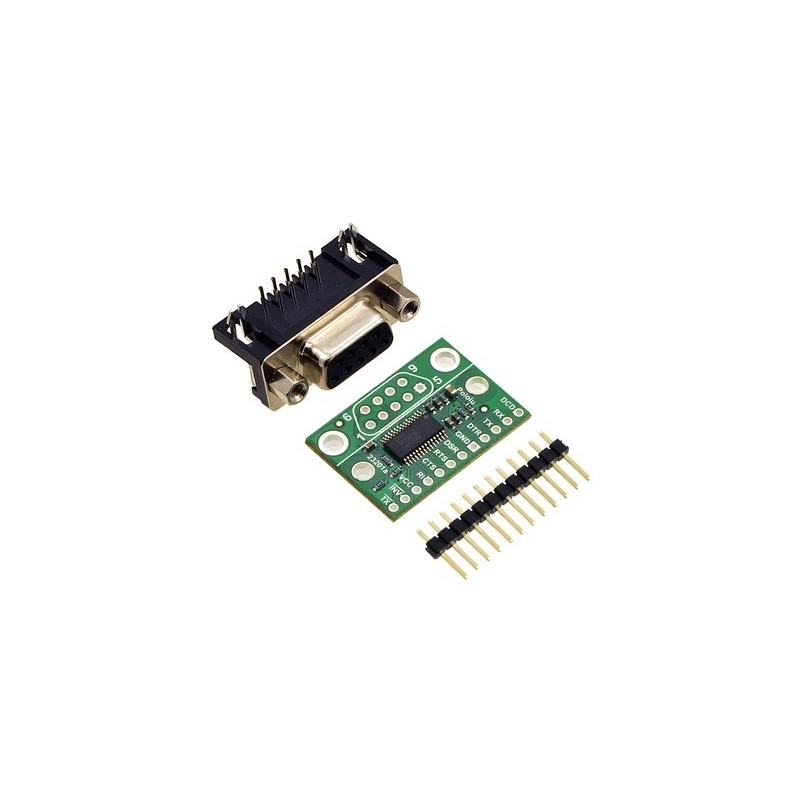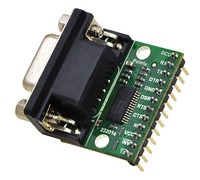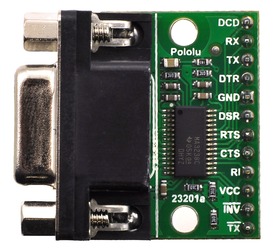

This item is the partial kit version of the 23201a serial adapter. All surface-mount components are assembled; the 12-pin header and DB9 connector are included but not soldered.
Dec 8, 2011 Update: We are now shipping a new revision of this serial adapter featuring a built-in power capacitor that makes this part less susceptible to damage from destructive LC voltage spikes. These new revisions are more robust drop-in replacements for the previous adapter version (they have the same dimensions, pin-out, and functionality).
 |
If you want to access all of the features on your computer’s serial port, this serial adapter is for you. The adapter allows you to connect your 3-5.5 V logic circuits to a COM port, which operates on higher and negative voltages (EIA-232, similar to the older RS-232 standard). The adapter is available fully assembled with male header pins facing down for use with prototyping boards and breadboards, or as a partial kit as shown to the right. The partial kit offers more flexibility if you do not need all of the header pins or if you want to install them on the other side of the board (or not at all).
This adapter distinguishes itself from most competing units through its five drivers and three receivers, which give you access to all eight signal lines on a DB9 connector (the ninth pin is ground). This means that in addition to standard serial communication, your project can also use all of the handshaking lines and status lines. Even if you do not use them for their intended purposes, you might find it convenient to be able to reset your processor using one of the extra lines. A connection detection line gives your project additional options for responding to a physical connection to a serial port. All of this connectivity comes in a compact package that is less than twice the size of the DB9 connector alone.
The first nine pins on the deluxe serial adapter correspond to the same nine pins on a COM port DB9 connector. The additional pins are the logic supply voltage, the serial connection detection pin, and an inverted version of the transmit line (which can be useful if, for instance, you have a positive-edge triggered interrupt that you want to fire in response to the beginning of the start bit). The TX line and RX lines are labeled from the computer’s perspective, so the TX pin has data transmitted by the computer that should be connected to your project’s receive input.
 |
| Pin | Type | Function |
|---|---|---|
| DCD | In | "Data carrier detect" |
| RX | In | Asynchronous serial data receive |
| TX | Out | Asynchronous serial data transmit (idle high) |
| DTR | Out | "Data terminal ready" control output (often used with DSR) |
| GND | Power | Ground |
| DSR | In | "Data set ready" control input (often used with DTR) |
| RTS | Out | "Ready to send" control output (often used with CTS) |
| CTS | In | "Clear to send" control input (often used with RTS) |
| RI | In | "Ring indicator" control input |
| VCC | Power | Logic supply voltage (3 – 5.5 V, externally supplied) |
| INV | Out | Serial port detection pin, high if serial port connected |
| TX | Out | Asynchronous serial data transmit, inverted (idle low) |
 |
Pololu USB-to-Serial Adapter |
 |
Pololu 23201a Serial Adapter Fully Assembled |
Producent BTC Korporacja sp. z o. o. Lwowska 5 05-120 Legionowo Polska sprzedaz@kamami.pl 22 767 36 20
Osoba odpowiedzialna BTC Korporacja sp. z o. o. Lwowska 5 05-120 Legionowo Polska sprzedaz@kamami.pl 22 767 36 20
Konwerter USB-UART oparty na układzie FT232RL firmy FTDI. Może być wykorzystany do wymiany danych między komputerem a mikrokontrolerem lub do programowania mikrokontrolerów przez interfejs szeregowy. Sparkfun DEV-09716
USB-TO-TTL-FT232-M to kompaktowy konwerter USB-UART z przylutowanym złączem, przeznaczony do szybkiego i bezpiecznego połączenia z mikrokontrolerami i modułami szeregowymi. Dzięki zastosowaniu układu FT232RNL, zabezpieczeń ESD i wskaźników LED, moduł sprawdza się w aplikacjach deweloperskich, diagnostycznych i wbudowanych. Idealny wybór dla inżynierów systemów embedded i twórców prototypów.
Płytka bazowa dedykowana do modułów ESP32 CAM. Pozwala na podłaczenie kamery za pomocą interfejsu USB np. do komputera. ESP32-CAM-MB
Brak towaru
Moduł z konwerterem USB - GPIO/ADC/I2C oparty na układzie MCP2221A. Pozwala podłączyć do komputera czujniki, wyświetlacze, czy sterowniki PWM przez złącze 2,54 mm lub Stemma QT/Qwiic. Adafruit 4471
Konwerter UART - RS232 z gniazdem DB9. Waveshare rs232-board
Konwerter UART-USB oparty na układzie CP2102, moduł wyposażony jest w gniazdo micro-USB. Poziom logiczny to 3,3V lub 5V
Konwerter USB-UART oparty na układzie CH340N. Wykorzystuje złącze USB typu C i zapewnia stabilną i bezpieczną komunikację między komputerem a urządzeniami wykorzystującymi interfejs UART
Konwerter USB - UART oparty na układzie FT232RL. Kompatybilny z napięciami 3,3 V oraz 5 V, został wyposażony w złącze USB typu C. Waveshare FT232 USB UART Board (Type C)
Moduł konwertera USB - UART (TTL), FT232RL, zgodny z RoHS
Konwerter USB - UART oparty na układzie FT232RL. Kompatybilny z napięciami 3,3 V oraz 5 V, został wyposażony w złącze microUSB. Cytron UC00A
ZL5USB to moduł konwertera USB - UART, działający w oparciu o układ CP2102. Moduł cechuje się niewielkimi wymiarami, ma złącze microUSB, i może współpracować z sygnałami o napięciu 2,5-5,5V
Konwerter RS232 - UART oparty na układzie MAX3238. Wykorzystuje wszystkie linie interfejsu RS232, dzięki czemu użytkownik ma do dyspozycji wszystkie funkcjonalności standardu. Pololu 126
Brak towaru
KAmod USB-UART-mini to kompaktowy konwerter USB-C na UART, oparty na układzie FT230XS, umożliwiający komunikację z prędkością od 300 bps do 3 Mbps i zapewniający opcję montażu za pomocą dodatkowego panelu frontowego; zawiera wskaźniki LED, współpracuje z napięciem sygnałów 3,3 V, opcjonalnie 5 V, i oferuje wsparcie dla Windows, Linux oraz Mac
Konwerter dedykowany do zastosowań w przemyśle. Zapewnia komunikację pomiędzy interfejsem USB a standardem szeregowym RS422 i RS485
Konwerter UART-USB oparty na układzie CP2102, moduł jest wyposażony w gniazdo mini-USB. Poziom logiczny to 3.3V lub 5V. Waveshare CP2102 USB UART Board (mini)
Konwerter USB - UART oparty na układzie FT232RNL. Kompatybilny z napięciami 3,3 V oraz 5 V, został wyposażony w złącze miniUSB. Waveshare FT232 USB UART Board (mini)

